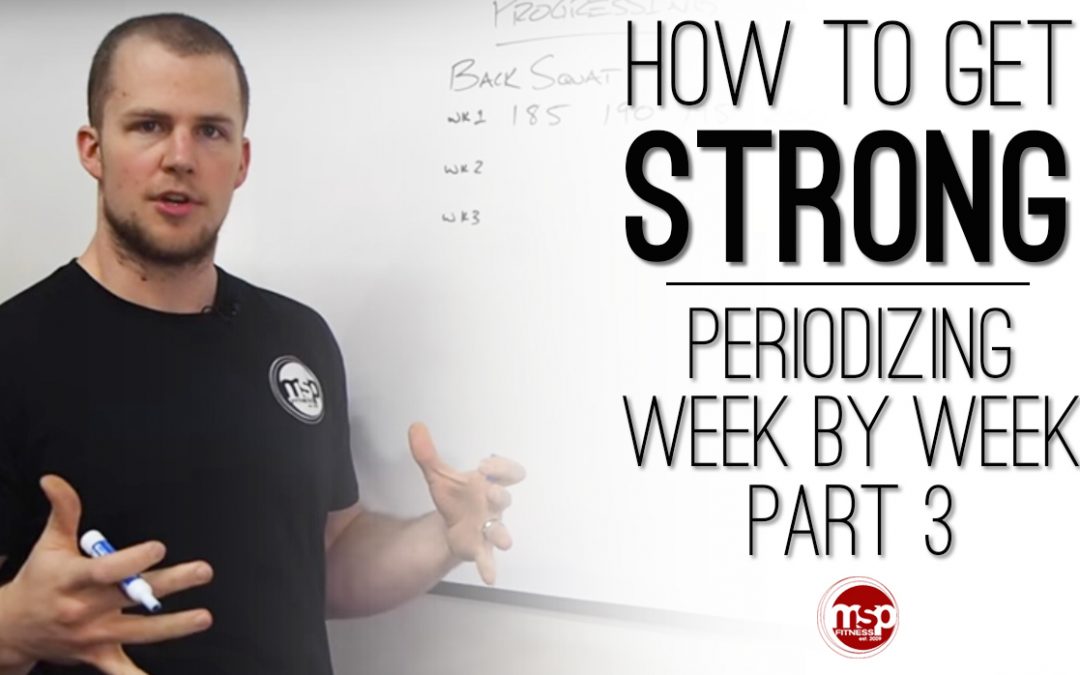Welcome back guys and gals! This post is the third and final in a multi-part series on progressing in strength training. During this video blog series we’ve been answering questions like…
1. Why am I not getting better with my barbell movements? AND
2. How do I get stronger over a long period of time?
In our first post, I gave you an overview of how to warm up to a target work set. In our second, Michael had a great video discussing how to get strong by structuring out your working sets. Today, I have the pleasure of wrapping the series up by showcasing how to progress in your strength training week after week — essentially proper progression of load.
A few qualifications:
If you have not read part two of this series, you may want to start there as I am relying heavily on Michael’s example laid out in that video. If you remember, our hypothetical lifter was performing sets of Back Squat. We’re going to pick up where that example left off so run on over and acquaint yourself with the back story.
Second, the information in this post is predicated on the assumption that you are keeping record of your lifts. Not just the quantifiable data (sets, reps, and loads), but qualitative data as well. Your desired progress hinges on the small notes you jot down regarding how you felt overall that day. How heavy did the last set feel? Did you have to grind any reps out? Answering miniature questions like these, combined with the record of your numbers, gives you a more complete picture of your training and is paramount for long term progress.

 Third and lastly, I’m taking liberty in presuming you are training Back Squat (the lift du jour) on a regular basis. Constantly varied functional training looks great and wonderful, but don’t kid yourself when it comes to performance improvements. If you are not seeing repeated exposures of a similar movement pattern, you have no help of getting better at that movement pattern. So if your goal is to progress and you value getting stronger, we hope you’re in a training program, at a gym, or with a coach who is exposing you to the lift that you want to get stronger at on a regular basis. If not, it might be time to switch things up!
Third and lastly, I’m taking liberty in presuming you are training Back Squat (the lift du jour) on a regular basis. Constantly varied functional training looks great and wonderful, but don’t kid yourself when it comes to performance improvements. If you are not seeing repeated exposures of a similar movement pattern, you have no help of getting better at that movement pattern. So if your goal is to progress and you value getting stronger, we hope you’re in a training program, at a gym, or with a coach who is exposing you to the lift that you want to get stronger at on a regular basis. If not, it might be time to switch things up!
How to Make Long-Term Strength Progress:
If we look to our example (pictured below), it’s week two and we’ve got our quantitative and qualitative data from week one. It’s time to answer how we are going to craft out the training environment for the weeks to come.
I’ll start by saying that in an ideal world, it shouldn’t be the exact same thing — that’s not the definition of progress. That being said, I need to let you know that the exact same loads as the previous training environment isn’t the end of the world. What happens if you were on your feet abnormally long that day, got caught in traffic on the way to the gym, or life stressors landed in your lap the night before your squat workout? Life happens sometimes! As we say at MSP Fitness, “does it feel like someone accidentally bumped the gravity switch today?” There is nothing wrong with repeating the previous session’s intensity (or lighter) if that’s what the body calls for.

Progress is a zoomed out, 30,000ft view of this thing we call training. I find it helpful to be concerned with the day by day and week by week numbers, but more focused on the cumulative progress you’ll make month after month and year after year if you stay consistent and diligent.
Back to Our Example:
Because we have the previous week’s loading data (along with our notes in the margin) we are ready to chart the next training environment. If our hypothetical lifter followed Michael’s advice in our previous post, their final set at 200lbs was truly tough. As long as that is true, I wouldn’t encourage they start the next week’s first work set higher than where the previous finished. Being greedy for gains is great, but so is building progressively over multiple sets. We like to tell folks, “sneak up on your PR’s.” Therefore, I would encourage the next week’s first work set to start somewhere around the middle sets of the previous week. In our example (pictured below) that means commencing around 190-195lbs.

In keeping with the 8-12% rule highlighted in part two of this strength series, our lifter can easily progress to a load that exceeds the fourth and final set of the week before. THIS is progress! In the training sessions that follow, I can continue my load selection based off the previous week’s middle set performance. Clearly our example presents a self imposed glass ceiling in that our lifter won’t make 5-10lb jumps every week for the rest of his/her life, but this framework can be implemented continually for strength progress. As a conclusion, I encourage you to hang your hat on grabbing the load from your middle work sets and choosing them as the start point for the next training session in a similar discipline or lift.
We hope that from the examples showcased above, you can see how to translate the principles presented to any strength training scenario. If you haven’t seen our correlating posts on how to warm up for strength gains and how to progress through work sets, make sure to check them out. In the mean time join the conversation on Facebook and get to training!
-Written by Taylor Gish and Michael S. Pilhofer
We at MSP Fitness feel passionately that under a proper training program and coach, you never have to plateau. The hallmark of a quality professional is their ability to produce results. If you are in the Minneapolis / St. Paul area and aren’t satisfied with your current fitness experience OR you’re looking for a coach who can help you reach your strength, health, and wellness goals, CONTACT US today!


